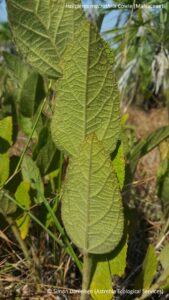In May 2019 I conducted a survey with Chris Brock from Brock Environmental for the threatened shrub Helicteres macrothrix (Malvaceae) Cowie – previously known as Helicteres sp. Glenluckie Creek (N.B. Byrnes 1280).
This species is listed as endangered under both Northern Territory and Commonwealth legislation.
H. macrothrix is an erect, densely clumping subshrub growing to approximately 60 cm tall. The leaves and stems are covered with a dense indumentum of long, stellate trichomes (= hairs) with a diameter up to 4.5 mm wide (Cowie, I., 2011).

It is restricted to a small area approximately 80 km south east of Darwin, where it has been recorded from three main sub-populations in the Mt Bundey, Coomalie Creek and Lake Bennett areas (with an outlier north of Acacia Hills) (Australasian Virtual Herbarium, 2019).

Our survey was located north of Lake Bennett. As is often the case with threatened species surveys, the timing of the survey (late wet season/early dry season) and prior weather conditions (the Top End had a very dry wet season this year) were not optimal for flowering. However, we were pleased to find that this species appears to be quite readily identifiable (and observable) well into the dry season, in the absence of reproductive material and even after burning.
We found it closely associated with a combination of Eucalyptus tectifica woodland with Wildman siltstone (the latter being an early Proterozoic metamorphosed siltstone), growing among a tall, dense to sparse grassy ground layer generally dominated by Sarga intrans and Heteropogon triticeus with Schizachyrium fragile.
It was always present in lower landscape positions, on gently undulating run-on surfaces or on level plains isolated from adjacent slopes.

In general, it was growing in sparse to mid-dense groups (see picture above), but occasional outlying individual plants were observed, sometimes many hundreds of metres from the main population. However, within our survey area it was unfailingly associated with E. tectifica.

Some parts of our site had been burnt a few weeks prior to our survey. However, H. macrothrix appears to be one of the first plants to recover after fire, and sprouts that were identifiable to species and already a few inches tall were easily observable.
In fact, H. macrothrix regrowth was obvious in this situation, given that little other regrowth had yet occurred.
H. macrothrix is superficially similar to H. darwinensis and H. integrifolia but can be discriminated relatively easily from these in the absence of reproductive material, as it has:
- an erect, multi-stemmed habit – c.f. H. darwinensis, a prostrate species,
- crowded inflorescences (see picture above – the spent calyces are persistent),
- very coarse, congested stellate hairs (macrothrix = large hairs) to 4.5 mm dia. – much larger than both H. darwinensis and H. integrifolia.
In addition, H. macrothrix is not associated with laterite (c.f. H. darwinensis) and only grows in sandy soils that are derived from granite (c.f. H. integrifolia).
The Northern Territory Herbarium (DNA) has prepared a number of excellent resources on this species, and should be consulted in relation to ID questions and in relation to survey design – in particular see:
https://nt.gov.au/__data/assets/pdf_file/0006/405537/helicteres-macrothrix-mapped-distribution.pdf
https://nt.gov.au/__data/assets/pdf_file/0005/208445/helicteres-macrothrix.pdf
Ian Cowie’s 2011 description of the species and his treatment of Helicteres from the NT is available at:

Your point of view caught my eye and was very interesting. Thanks. I have a question for you.
Productivity steroids! AI Tools Directory offers more hacks than a hacker convention. This AI Tools Directory is legally questionable greatness! 😎
Just here to join conversations, share experiences, and learn something new along the way.
I like hearing diverse viewpoints and adding to the conversation when possible. Interested in hearing fresh thoughts and building connections.
There is my site-https://automisto24.com.ua/
Here to join conversations, share thoughts, and gain fresh perspectives throughout the journey.
I’m interested in learning from different perspectives and sharing my input when it’s helpful. Always open to new ideas and meeting like-minded people.
That’s my site:https://automisto24.com.ua/